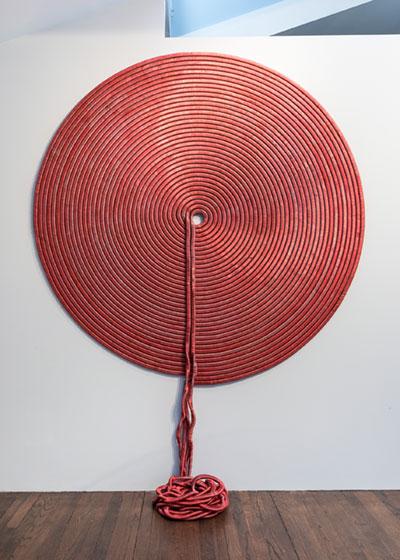Hamada, Hope, and Hunt Take Guild Hall

Guild Hall is tripling down on its commitment to the work of East End artists this weekend with three new exhibitions: solo shows of work by Alice Hope and Hiroyuki Hamada, both of whom live and work in East Hampton, and an exhibition of artwork selected from the museum’s collection by Bryan Hunt, an artist who has a house and a studio in Wainscott.
Ms. Hope will create a site-specific installation. “She is going to bring all the materials,” said Christina Strassfield, the museum’s director and chief curator, who is organizing the Hope and Hamada exhibitions, “and deploy them in whatever way she wants. You’re going to be able to walk through some of the pieces, and others will hang from the walls and ceiling.”
Ms. Hope’s preferred materials include tabs from soda and beer cans, perforated aluminum, iron filings, ball chain, magnets, and inner springs, which she transforms with scale, pattern, and repetition.
“I think her work really bridges the high-low, because the materials she uses have an industrial quality, but the environments she creates are exciting and often shimmery,” Ms. Strassfield said.
The configurations of certain pieces belie their materials. What appears from a distance to be a coil of rope, for example, is actually a spiral construction of can tabs and tubing. A wall-mounted chrome trash can is festooned with tabs and ball chain that flicker and sway as people move through the gallery.
Mr. Hamada will fill his gallery with a massive sculpture of pigmented resin and a selection of large prints. Built up from small, individual panels, the sculpture suggests a kind of menacing machine, something out of a dystopian science-fiction vision. His past sculptural output has combined biomorphic shapes with materials ranging from plaster, painted resin, tar, and wood to wax, among others.
The prints, which depict solid, vaguely organic shapes that echo his three-dimensional objects, were produced by Piezography, a black-and-white printing process in which seven channels of a large-format printer are loaded with seven shades of carbon pigment black ink. “When you look at them, you get this feeling of a solid, solid black shading into sfumato,” Ms. Strassfield said, referring to a fine shading technique used by Leonardo da Vinci.
“The Artist Curated Collection: Toward Abstraction” is the first of an ongoing series in which artists will draw on their unique perspectives to organize shows from the museum’s holdings. “I’m excited about Bryan’s show because I have worked with him before, and he’s a wonderful artist,” Ms. Strassfield said. Mr. Hunt had a solo exhibition at Guild Hall in 2011.
“Toward Abstraction” consists of paintings and works on paper that illuminate the various paths artists have taken from representation to abstraction. Among the artists included are Jackson Pollock, Hedda Sterne, Grace Hartigan, Lee Krasner, Roy Lichtenstein, Andy Warhol, Willem de Kooning, Richmond Burton, and Eric Fischl.
“There are legends, and there are discoveries,” said Mr. Hunt. This was his first turn as a curator, and he worked closely with Jess Frost, he said, the museum’s associate curator of the permanent collection and registrar.
“I was looking at works for what they were, not for who made them. The artworks had a point of departure, where realism breaks into an open-ended, interpretive kind of thing. They all have a foot in some sort of realism, but from that point on they go out into abstraction.”
Among the surprises he noted were an early Andy Warhol “that’s a very light, figurative drawing — you wouldn’t even know that it’s a Warhol. And some early Lichtenstein drawings that made you say, ‘Wow, Roy did that?’ ”
The exhibitions will open on Saturday and remain on view through March 25. A private reception for members will take place on Sunday from 2 to 4 p.m.
